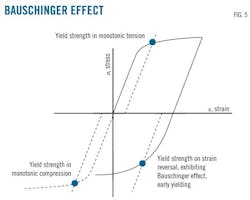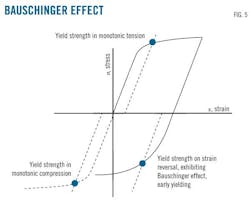P. 3 ~ Continued - Research nears deepwater intercontinental gas pipeline
Displaying 3/4
View Article as Single page
The Bauschinger effect is not fully understood but adheres to this general principle: When a material experiences a tensile stress, it first generates an elastic strain and eventually begins to yield, at which point the relationship between the stress and the induced strain becomes non-linear and the material begins to transform plastically (Fig. 5). During plastic transformation the resistance of the material to strain reversal also lessens. Removing tensile stress and then applying the opposite, compression, causes compressive yield to occur earlier.
This series of events occurs during cold-forming of UOE pipe. The final step in UOE manufacture is pipe expansion, the E in UOE, exposing the pipe to tensile stress and reducing its performance under compression.
The first compressive stress the pipe encounters after manufacture is hydrostatic compression at seabed, justifying the derating of UOE-manufactured pipes' collapse pressure since included in both DNV and API design codes.
Pipes with above-average collapse pressures during the Oman-to-India trial underwent additional research to determine if the higher collapse values stemmed from the manufacturing process.4
Subsequent investigation determined the forming equipment used in manufacturing these pipes allowed lower amounts of expansion and higher levels of compression in the O press stage, seemingly reducing Bauschinger's effect and improving shape. The overall increase in collapse pressure allowed removal of the overall 15% derating from the DNV equation.5
Equation 4 simplifies resolution of the resulting DNV cubic equation regarding WT.
Applying Equation 4 to the Middle East-to-India pipeline (3,500-m water depth; 28-in OD, and 42.7-mm WT) yields a WT savings of around 2.5 mm. A thinner pipe wall is both logistically easier and less expensive for a project of this scale.
Additional research is under way at the University of Naples Federico II to find a robust analytical treatment for hydrostatic collapse capable of improving understanding of the mechanisms and perhaps allowing pipe manufacturing or installation procedures to reach the point at which delivery of these large intercontinental infrastructure projects will be feasible.
The theoretical equation under development describes the transformation of the pipe shape through the elastic and plastic transition by building on Gerrard's work, which looked at collapse using the actual shape of the stress strain curve as defined by the tangent modulus, instead of using Young's modulus with an assumed value for the yield strength. This approach allows the new equation to incorporate the strain hardening of the material through the Ramberg-Osgood relationship.
The technique demonstrates good correlation with experimental results and work is underway to add more complexity to the formula to examine the effects of non-homogeneous materials. Once all of the factors driving collapse are understood researchers will attempt to re-simplify the equation for incorporation into design standards. Insight into how shape can influence the onset of collapse could also lead to potential manufacturing improvements.
Displaying 3/4
View Article as Single page

